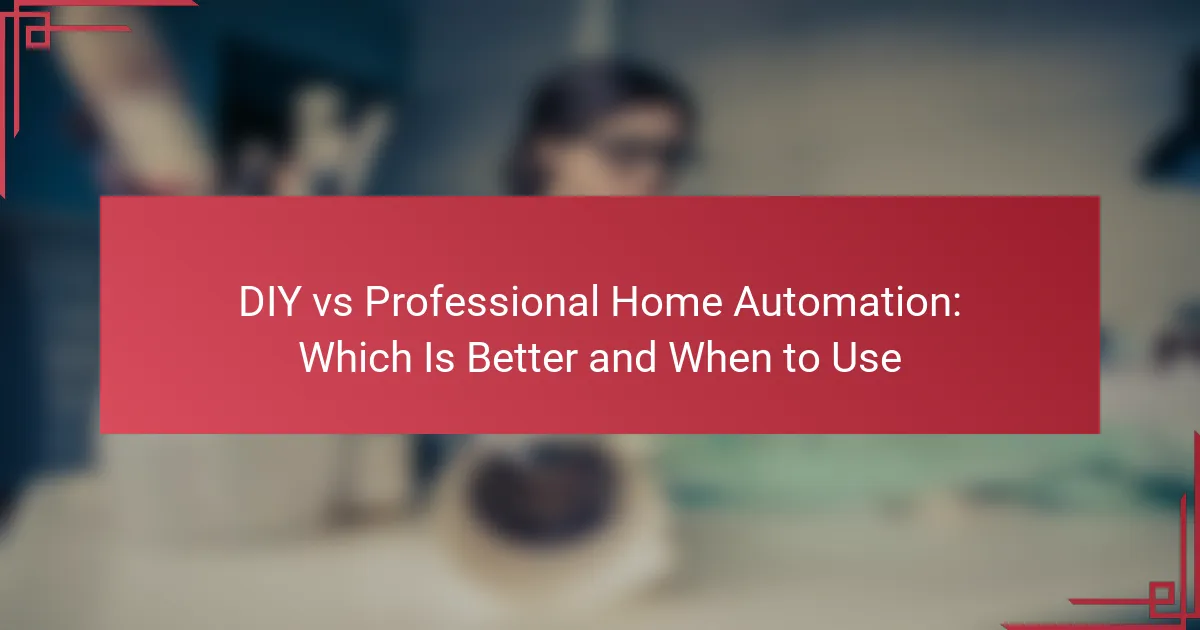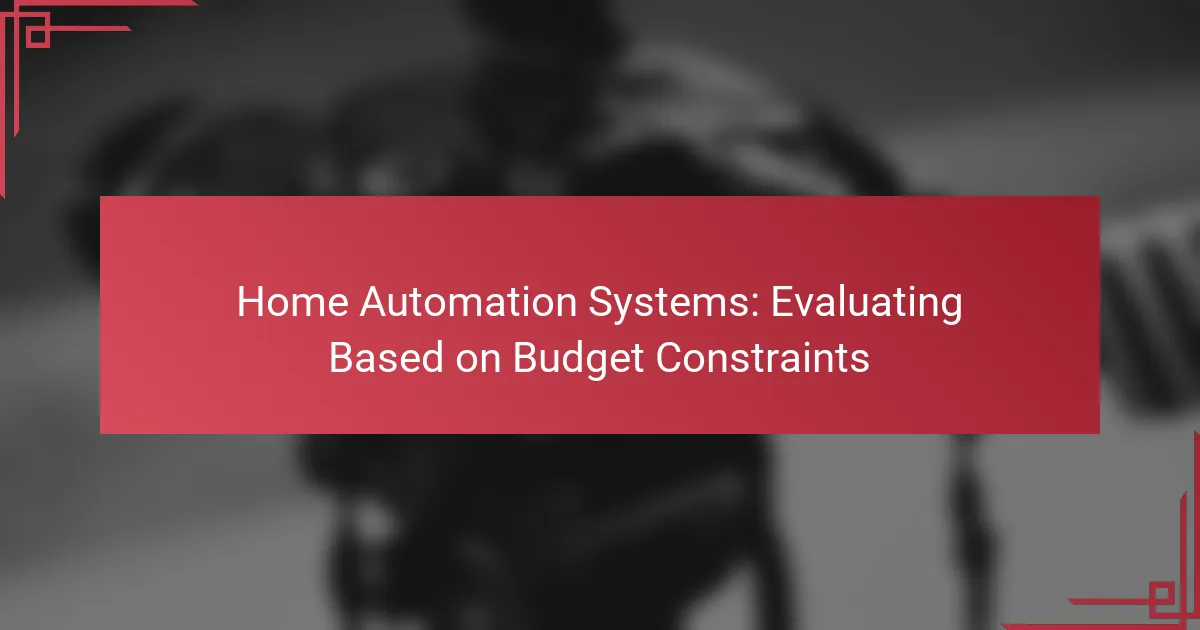User-friendly home automation systems are designed specifically for individuals who may not be tech-savvy, providing intuitive interfaces and easy setup processes. These systems enhance daily living by simplifying tasks and allowing effortless control of smart devices, ultimately improving comfort and convenience at home.
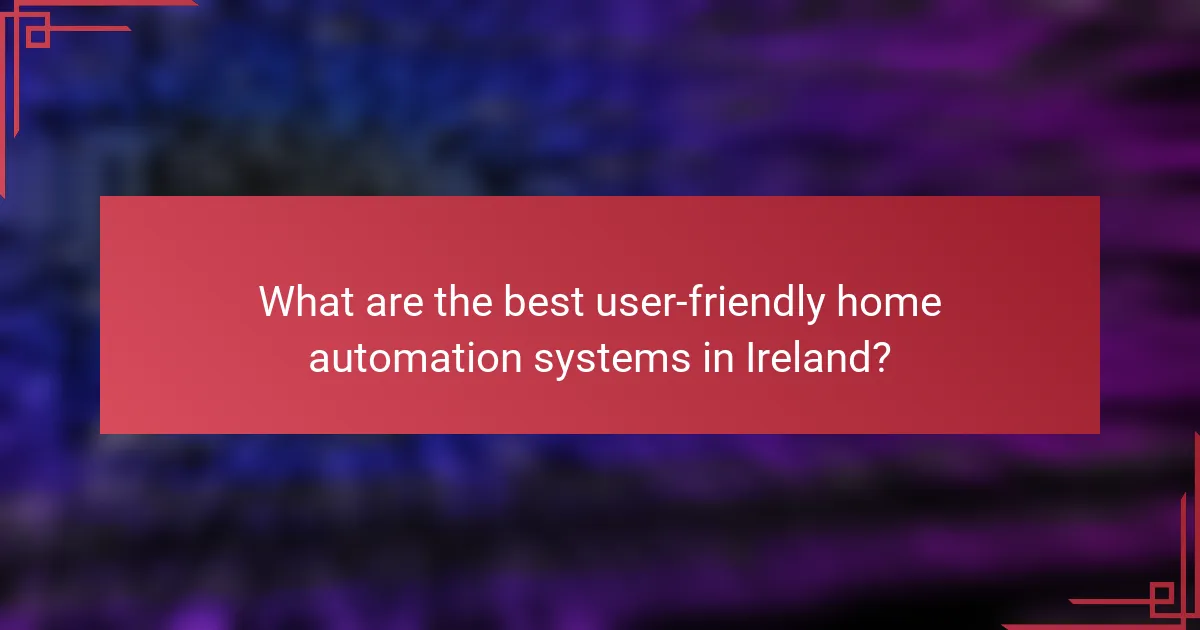
What are the best user-friendly home automation systems in Ireland?
The best user-friendly home automation systems in Ireland cater to individuals who may not be tech-savvy, offering intuitive interfaces and straightforward setup processes. These systems enable easy control of smart devices, enhancing convenience and comfort in daily life.
Google Nest Hub
The Google Nest Hub is a versatile smart display that integrates seamlessly with various smart home devices. It allows users to control lights, thermostats, and cameras through voice commands or a touch interface, making it ideal for those who prefer simplicity.
Setting up the Google Nest Hub is straightforward, requiring only a Wi-Fi connection and a Google account. Users can easily access Google Assistant for hands-free control, and the visual display provides helpful information like weather updates and calendar events.
Amazon Echo Show
The Amazon Echo Show combines the functionality of a smart speaker with a touchscreen display, providing an easy way to manage home automation. Users can control compatible devices, make video calls, and access a variety of apps, all through voice commands or touch.
To get started with the Echo Show, users simply connect it to their Wi-Fi network and link their Amazon account. Its integration with Alexa makes it user-friendly, allowing for simple voice commands to adjust settings or check on smart devices.
Apple HomePod Mini
The Apple HomePod Mini is designed for users within the Apple ecosystem, offering an easy way to control smart home devices through Siri. Its compact design and high-quality sound make it a great addition to any room, while still providing powerful automation features.
Setting up the HomePod Mini involves connecting it to a Wi-Fi network and using the Home app on an iPhone or iPad. Users can easily control their smart devices, play music, and access information with simple voice commands, making it accessible for non-tech-savvy individuals.
Samsung SmartThings
Samsung SmartThings is a comprehensive home automation platform that allows users to connect and control a wide range of smart devices from different brands. Its user-friendly app provides a central hub for managing everything from lights to security systems.
To use SmartThings, users need to download the app and create an account. The platform supports a variety of devices, making it flexible for different setups. Users can create automation routines, such as turning off lights when leaving home, which enhances convenience.
TP-Link Kasa Smart Home
TP-Link Kasa Smart Home offers a range of user-friendly smart devices, including plugs, bulbs, and cameras, all manageable through a single app. This system is particularly appealing for those looking to start small and expand their smart home gradually.
Setting up Kasa devices is simple; users just need to plug them in, connect to Wi-Fi, and follow the app instructions. The Kasa app provides an intuitive interface for scheduling, remote control, and monitoring, making it easy for anyone to manage their home automation.

How do these systems enhance daily living?
User-friendly home automation systems significantly improve daily living by simplifying tasks and enhancing comfort. They allow individuals, even those who are not tech-savvy, to control various aspects of their home environment easily.
Convenience through voice control
Voice control is a key feature of many home automation systems, enabling users to manage devices hands-free. By using smart speakers or voice assistants, individuals can adjust lighting, temperature, and even play music simply by speaking commands.
This convenience is particularly beneficial for those with mobility challenges or busy lifestyles. For example, saying “turn off the lights” can quickly eliminate the need to walk around the house, saving time and effort.
Energy efficiency and cost savings
Home automation systems can lead to significant energy efficiency and cost savings by optimizing energy use. Smart thermostats, for instance, learn user habits and adjust heating or cooling accordingly, which can reduce energy bills by a noticeable percentage.
Additionally, smart plugs and lighting systems can be programmed to turn off when not in use, further conserving energy. Users may see savings in the range of 10-30% on their utility bills, depending on their usage patterns.
Improved home security
Home automation systems enhance security through features like smart locks, cameras, and motion sensors. These devices can be monitored and controlled remotely, providing peace of mind when away from home.
For example, users can receive alerts on their smartphones if unusual activity is detected, allowing for quick responses. Integrating these systems can significantly reduce the risk of break-ins and improve overall safety.

What features should non-tech savvy individuals look for?
Non-tech savvy individuals should prioritize user-friendly features in home automation systems, such as simple controls, clear instructions, and seamless integration with existing devices. These elements ensure ease of use and minimize frustration when adopting new technology.
Intuitive user interfaces
An intuitive user interface is crucial for non-tech savvy users, as it simplifies navigation and operation. Look for systems that offer touchscreens, voice commands, or mobile apps with straightforward layouts and clear icons. Avoid overly complex menus or jargon that can lead to confusion.
Consider systems that provide customization options, allowing users to arrange controls according to their preferences. This personalization can enhance comfort and familiarity, making the technology feel more accessible.
Compatibility with existing devices
Compatibility with existing devices is essential for a smooth home automation experience. Ensure that the system can easily connect with popular smart devices like lights, thermostats, and security cameras. Check for compatibility with major platforms such as Google Home, Amazon Alexa, or Apple HomeKit.
Before purchasing, verify that the new system can integrate with your current devices without requiring extensive setup or additional hardware. This will save time and reduce the likelihood of technical issues during installation.
Customer support and resources
Reliable customer support and accessible resources are vital for non-tech savvy individuals. Look for companies that offer comprehensive support options, including phone assistance, live chat, and online tutorials. A well-documented FAQ section can also be a valuable resource for troubleshooting common issues.
Consider systems that provide user-friendly guides and video tutorials, as these can help users understand features and functions more effectively. A supportive community forum can also be beneficial for sharing experiences and solutions with other users.
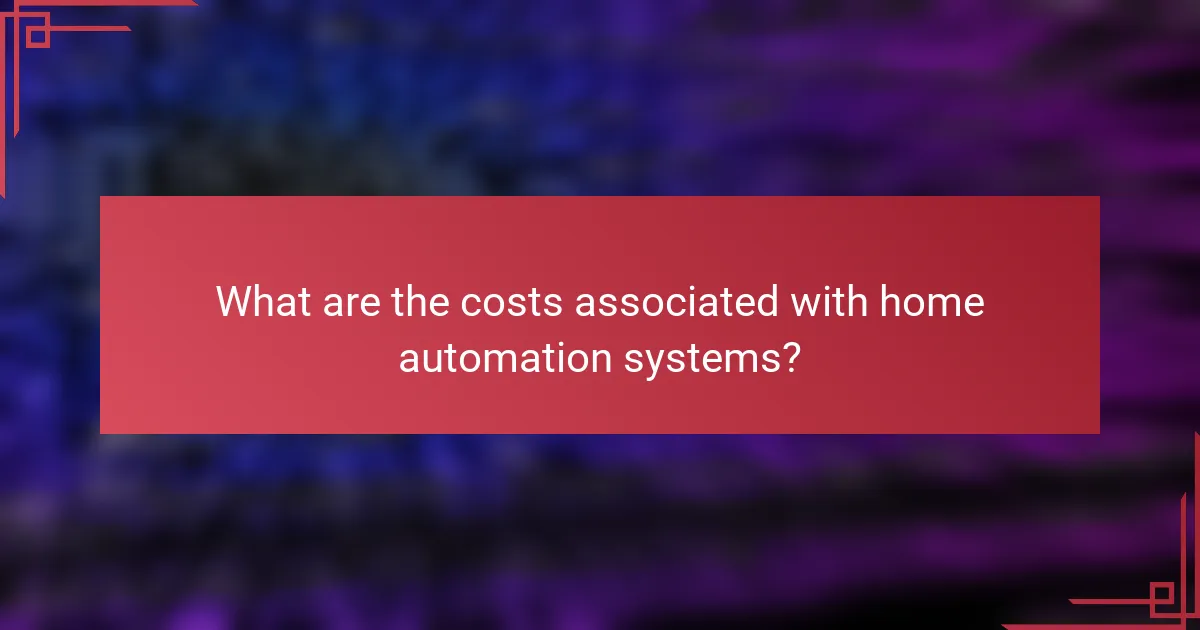
What are the costs associated with home automation systems?
The costs of home automation systems can vary widely based on the complexity of the setup and the specific features desired. Generally, you can expect to pay for initial setup, ongoing subscription fees, and potential savings on utility bills over time.
Initial setup costs
Initial setup costs for home automation systems typically range from a few hundred to several thousand dollars, depending on the number of devices and the complexity of the installation. Basic systems may start around $200, while comprehensive setups with multiple smart devices can exceed $2,000.
Consider whether you will install the system yourself or hire a professional. DIY installations can save money but may require technical knowledge, while professional installations ensure proper setup but add to the overall cost.
Monthly subscription fees
Many home automation systems come with monthly subscription fees that can range from $10 to $50 or more. These fees often cover cloud storage for security camera footage, advanced features, or customer support.
When evaluating subscription options, consider the features included in each plan. Some systems offer basic functionality without a subscription, while others may require ongoing payments for full access to smart home capabilities.
Long-term savings on utilities
Investing in home automation can lead to long-term savings on utility bills, particularly through energy-efficient devices like smart thermostats and lighting. Homeowners often report savings of 10-30% on energy costs after implementing these technologies.
To maximize savings, focus on devices that monitor and optimize energy use. For instance, smart thermostats can adjust heating and cooling based on occupancy, significantly reducing energy consumption over time.
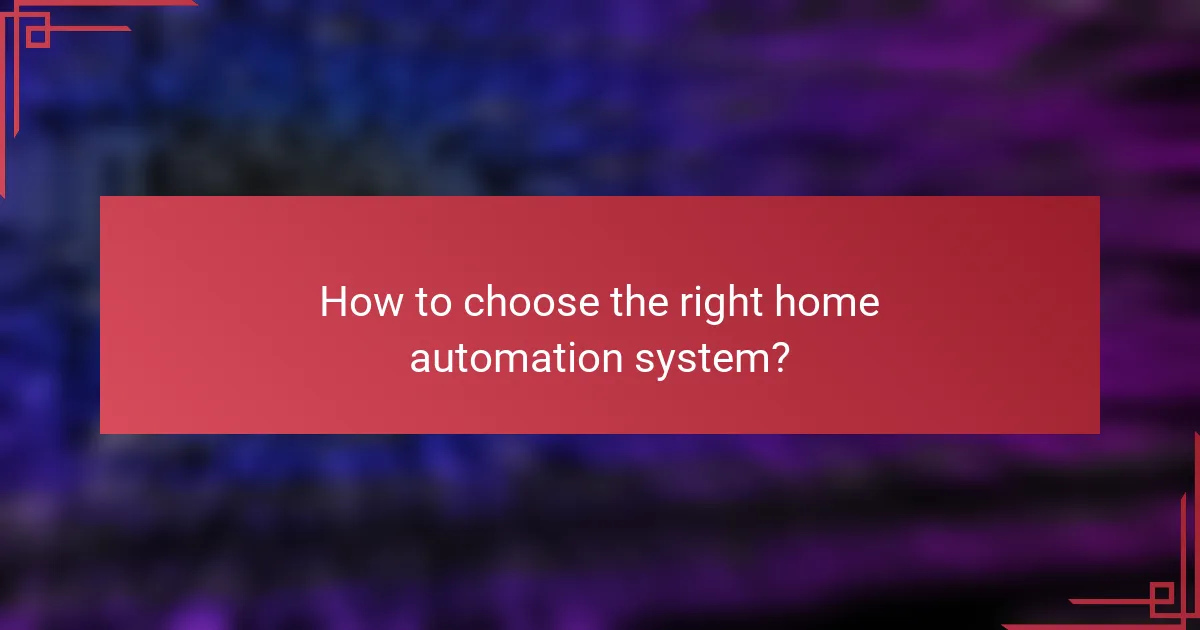
How to choose the right home automation system?
Choosing the right home automation system involves understanding your specific needs and evaluating available options based on ease of use, features, and budget. A user-friendly system should simplify daily tasks without overwhelming you with complexity.
Assessing personal needs and preferences
Start by identifying what you want to automate in your home. Common areas include lighting, security, climate control, and entertainment systems. Consider your lifestyle; for instance, if you travel frequently, a robust security system might be a priority.
Think about the level of control you desire. Some systems offer full automation, while others allow for manual overrides. Make a list of must-have features versus nice-to-haves to clarify your preferences.
Comparing features and prices
Once you know your needs, compare different systems based on their features and pricing. Look for systems that offer compatibility with existing devices and ease of installation. Prices can vary widely, from a few hundred to several thousand dollars depending on the complexity and number of devices.
Pay attention to subscription fees for cloud services or additional features. Some systems may have a lower upfront cost but higher ongoing expenses, so calculate the total cost of ownership over time.
Reading user reviews and testimonials
User reviews can provide valuable insights into the real-world performance of home automation systems. Look for feedback on ease of use, reliability, and customer support. Websites like Amazon or dedicated tech forums can be good sources for honest opinions.
Pay attention to recurring themes in reviews, such as common issues or standout features. Testimonials from non-tech-savvy users can be particularly useful, as they reflect experiences similar to your own.

What are the common challenges faced by users?
Users often encounter several challenges when navigating home automation systems, particularly if they lack technical expertise. Common issues include integration difficulties, usability concerns, and the complexity of setup and maintenance.
Integration issues with devices
Integration issues arise when different smart devices fail to communicate effectively with one another. This can happen due to incompatible protocols or lack of support for certain brands, making it frustrating for users trying to create a cohesive smart home environment.
To avoid integration problems, it’s essential to choose devices that are compatible with a common platform, such as Google Home or Amazon Alexa. Checking for certifications like “Works with Nest” or “Zigbee Certified” can also help ensure better interoperability.
Additionally, consider using hubs that can bridge multiple devices and protocols, simplifying the integration process. For example, a smart home hub can connect Zigbee, Z-Wave, and Wi-Fi devices, allowing for a more seamless experience.

